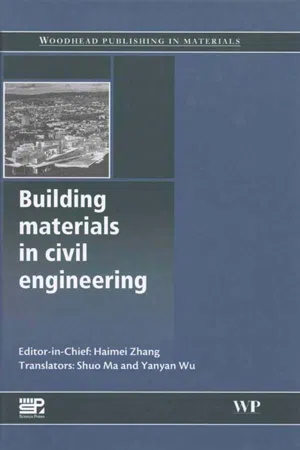Physics
Bulk Properties of Solids
Bulk properties of solids refer to the characteristics that describe the behavior of a solid as a whole, rather than at the atomic or molecular level. These properties include density, elasticity, thermal conductivity, and electrical conductivity. They are important for understanding how solids respond to external forces, heat, and electricity, and are fundamental to the study of materials science and engineering.
Written by Perlego with AI-assistance
4 Key excerpts on "Bulk Properties of Solids"
Learn about this page
Index pages curate the most relevant extracts from our library of academic textbooks. They’ve been created using an in-house natural language model (NLM), each adding context and meaning to key research topics.
- eBook - ePub
Particle Technology and Engineering
An Engineer's Guide to Particles and Powders: Fundamentals and Computational Approaches
- Jonathan P.K. Seville, Chuan-Yu Wu(Authors)
- 2016(Publication Date)
- Butterworth-Heinemann(Publisher)
Bulk solids are ubiquitous in nature, in our daily life, and in industrial applications. Based upon the sizes of the constituent particles, bulk solids can generally be classified into granular materials, in which the particles generally have a large size (say >1 mm), and powders, in which the particles are relatively small (say < 1 mm), as stated in the British Standard (1993). Rice, coffee, sugar, sand, and coal are typical granular materials, while flour, salt, and cement are typical examples of powders. Bulk solids are widely manufactured and used in various industries (Richard et al., 2005) and over 2/3 of the products of the chemical industries are either in the physical form of bulk solids or manufactured using some bulk solids. Bulk solids are unique in the sense that they can, according to the circumstances, show characteristics reminiscent of solids, liquids, or gases. For example, compacted bulk solids (such as tablets and ceramic parts) behave like a solid. Bulk solids can also flow from a storage hopper or container like a liquid, while highly agitated bulk solids in a confined space, e.g., under intensive vibration, behave similarly to a gas. Nevertheless, bulk solids exhibit distinctive properties that cannot simply be characterized using the methods developed for solids, liquids, and gases. In this chapter, some fundamental properties of bulk solids are defined, including density, surface area, flowability, compressibility and compactibility, and the techniques and methods which can be used to characterize these properties are also introduced. 2.1. Density Density is a fundamental property of any material and determines its physical behavior in various processes. Density is generally defined as the ratio of the mass to the volume of a material, but for bulk solids, several density definitions are introduced to reflect how the volume of the bulk solids is defined. Some of the most widely used densities for bulk solids are: 1. Solid density ρ s 2 - eBook - ePub
The Belt Conveyor
A Concise Basic Course
- D.V. Subba Rao(Author)
- 2020(Publication Date)
- CRC Press(Publisher)
Properties of bulk materialsBulk materials or bulk solids consist essentially of many particles or granules of different sizes (and possibly different chemical compositions and densities) randomly grouped together to form a bulk. Bulk materials are stored and handled in volumes often in unpackaged form. Examples include dry powders, granules, flakes and resins. Ores, minerals, coal, fertilizer, sulphur and salt are other common types of bulk materials.Bulk materials are generally the most difficult state of matter to handle. Bulk materials handling is characterized by continuous-flow operations, involving materials in an aggregate form. In many cases, the bulk materials assume flow characteristics similar to those of fluids. Elements of a typical bulk materials handling system are as follows:- bins, silos, hoppers, bunkers for storing the material (see Section 8.1 )
- discharge devices or feeders (see Section 8.2 )
- conveyors
- flow aid devices when needed (see Section 8.4 ).
2.1 Properties of bulk materials
2.1.1 Particle size
Various terms are in use to give a qualitative indication of the size of the particles constituting bulk materials; the word ‘size ’ here is used loosely to mean some sort of average dimension across the particle. Table 2.1 shows the qualitative terms used to describe the size of bulk materials:Table 2.1 Qualitative terms for various sizesDescriptive term Typical size range Examples Coarse (or broken) solid 5–100 mm Coal, ore, aggregates, etc. Granular solid 0.3–5 mm Granulated sugar (0.3–0.5 mm); rice (2–3 mm) Particulate solid: Coarse powder 100–300 μm Table salt (200–300 μm) Fine powder 10–100 μm Icing sugar (≅45 μm) Superfine powder 1–10 μm Face powder Ultrafine powder <1 μm Paint pigments The size of the particle of standard configurations such as sphere and cube can easily be specified. For example, the size of a spherical particle is its diameter (d ) and that of a cubical particle is the length of its side (l ), as shown in Figure 2.1 - eBook - ePub
- Zeki Berk(Author)
- 2008(Publication Date)
- Academic Press(Publisher)
Sahin and Sumnu, 2006 ; Figura and Teixeira, 2007 ). The number of scientific meetings on related subjects held every year is considerable. Specific courses on the subject are being included in most food science, engineering and technology curricula.Some of the ‘engineering’ properties will be treated in connection with the unit operations where such properties are particularly relevant (e.g. viscosity in fluid flow, particle size in size reduction, thermal properties in heat transfer, diffusivity in mass transfer etc.). Properties of more general significance and wider application are discussed in this chapter.1.2. Mechanical Properties
1.2.1. Definitions
By mechanical properties, we mean those properties that determine the behavior of food materials when subjected to external forces. As such, mechanical properties are relevant both to processing (e.g. conveying, size reduction) and to consumption (texture, mouth feel).The forces acting on the material are usually expressed as stress, i.e. intensity of the force per unit area (N.m−2 or Pa.). The dimensions and units of stress are like those of pressure. Very often, but not always, the response of materials to stress is deformation, expressed as strain. Strain is usually expressed as a dimensionless ratio, such as the elongation as a percentage of the original length. The relationship between stress and strain is the subject matter of the science known as rheology (Steffe, 1996 ).We define three ideal types of deformation (Szczesniak, 1983 ):- Elastic deformation: deformation appears instantly with the application of stress and disappears instantly with the removal of stress. For many
materials, the strain is proportional to the stress, at least for moderate values of the deformation. The condition of linearity,
called Hooke's law (Robert Hooke, 1635–1703, English scientist) is formulated in Eq. (1.1) :(1.1)
where
- E=Young's modulus (after Thomas Young, 1773–1829, English scientist), Pa
- F=force applied, N
- A0
- eBook - ePub
- Haimei Zhang(Author)
- 2011(Publication Date)
- Woodhead Publishing(Publisher)
The fuse mass with a certain chemical constituents is cooled so rapidly that the particles cannot be packed in a regular ordered pattern, and thus it is solidified into a solid, known as non-crystal or vitreous body or amorphous body. Non-crystal is characterized by no fixed geometry shape and isotropy. A large number of chemicals cannot be released because of the rapid cooling, so non-crystal materials have chemical instability, easily reacting with other substances. For example, granulated blast furnace slag, volcanic ash and fly ash can react with lime under water for hardening, which are used as building materials. Non-crystal plays the role of adhesive in products of burned clay and some natural rocks.2.2 Physical Properties of Materials
2.2.1 Density, Apparent Density and Bulk Density
1 Density
Density is the dry mass per unit volume of a substance under absolute compact conditions. It is defined by:(2.1)In this formula: ρ is the density (g/cm3 );m is the mass under dry conditions (g);V is the volume under absolute compact conditions (cm3 ).The volume under absolute compact conditions refers to the solid volume without the volume of inner pores. Except steel, glass, asphalt and a few other materials, most materials contain some pores in natural state. In the measurement of the density of a porous material, the material is ground into powder at first; the powder is dried to fixed mass; and then the solid volume is measured by Lee’s density bottle; finally the density is calculated by the above formula. The finer the powder is ground, the more real the size will be. Thus the density value is more correct.2 Apparent Density
Apparent density is the dry mass per unit volume of a substance under natural conditions. It is defined by:(2.2)In this formula: ρ 0 is the apparent density (kg/m3 );m is the mass under dry conditions (kg);V 0 is the volume under natural conditions (m3 ).The volume of a substance under natural conditions refers to the solid volume and the volume of inner pores. If it is a regular shape, the volume can be directly measured; if it is in an irregular shape, the volume can be measured by the liquid drainage method after sealing pores with wax; the liquid drainage method can be directly used to measure the volume of sandstone aggregate utilized in concrete but the volume here is the solid volume plus the volume of closed pores—without the volume of the pores open to the outside. Because the sandstone is compact with only a few pores, the volume of the pores open to the outside is little. Thus the volume measured by the liquid drainage method can be called apparent density which is called virtual density in the past.



